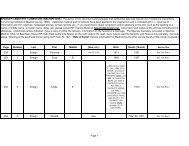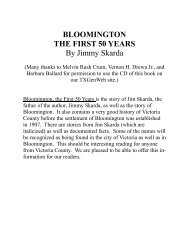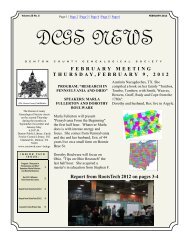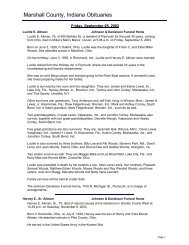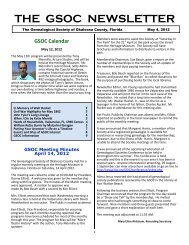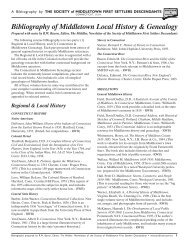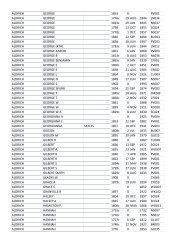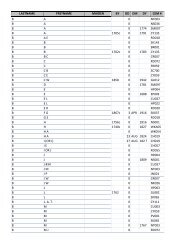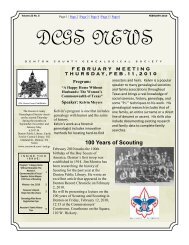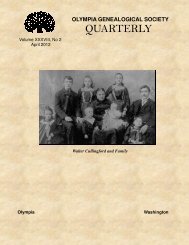Indian population in the United States and Alaska. 1910 - RootsWeb
Indian population in the United States and Alaska. 1910 - RootsWeb
Indian population in the United States and Alaska. 1910 - RootsWeb
Create successful ePaper yourself
Turn your PDF publications into a flip-book with our unique Google optimized e-Paper software.
STOCKS AND TRIBES, BY SEX, AGE, AND BLOOD. 103<br />
At present <strong>the</strong> tribe is located ma<strong>in</strong>ly on <strong>the</strong> Rosebud,<br />
Crow Creek, <strong>and</strong> Lower Brule Reserrations, S. Dak.<br />
The number enumerated <strong>in</strong> <strong>1910</strong> was 806, of which<br />
795 were <strong>in</strong> South Dakota.<br />
Eunkpapa Sioux.—A tribe or subdivision of <strong>the</strong><br />
Teton group of <strong>the</strong> Sioux. In <strong>the</strong> early part of <strong>the</strong><br />
n<strong>in</strong>eteenth century, <strong>the</strong>y occupied a considerable area<br />
<strong>in</strong> North Dakota, chiefly west of <strong>the</strong> Missouri. They<br />
are now located ma<strong>in</strong>ly on <strong>the</strong> St<strong>and</strong><strong>in</strong>g Rock Reservation<br />
<strong>in</strong> North <strong>and</strong> South Dakota. The nxomber<br />
enimierated <strong>in</strong>«<strong>1910</strong> was 1,072, of which 930 were <strong>in</strong><br />
South Dakota <strong>and</strong> 142 <strong>in</strong> North Dakota. Accord<strong>in</strong>g<br />
to <strong>the</strong> reports of <strong>the</strong> Commissioner of <strong>Indian</strong> Affairs,<br />
<strong>the</strong> number of this tribe <strong>in</strong> previous years was as fol-<br />
lows: 1875, 2,100; 1885, 1,805; 1890, 1,734.<br />
M<strong>in</strong>niconjou Sioux.—A tribe or subdivision of <strong>the</strong><br />
Teton group of <strong>the</strong> Sioux. In <strong>the</strong> beg<strong>in</strong>n<strong>in</strong>g of <strong>the</strong><br />
n<strong>in</strong>eteenth century <strong>the</strong>y occupied a considerable area<br />
along <strong>and</strong> west of <strong>the</strong> Missouri River, <strong>in</strong> South Dakota.<br />
They are now located on <strong>the</strong> Cheyenne River Reservation,<br />
S. Dak. The number enumerated <strong>in</strong> <strong>1910</strong> was<br />
397, of which 387 were <strong>in</strong> South Dakota <strong>and</strong> 10 <strong>in</strong><br />
North Dakota. Accord<strong>in</strong>g to <strong>the</strong> reports of <strong>the</strong> Com-<br />
missioner of <strong>Indian</strong> Affairs, this tribe was estimated at<br />
about 4,000 <strong>in</strong> 1875, had decreased to 1,221 <strong>in</strong> 1885,<br />
<strong>and</strong> risen to 1,268 <strong>in</strong> 1888, s<strong>in</strong>ce which date no separate<br />
figures are available.<br />
Oglala Sioux (syn. Loafer Sioux).—The largest tribe<br />
or subdivision of <strong>the</strong> Teton group of <strong>the</strong> Sioux. When<br />
first known to Europeans <strong>the</strong>y were liv<strong>in</strong>g along <strong>the</strong><br />
Missouri River <strong>in</strong> South Dakota. The majority of <strong>the</strong><br />
Oglala are now located on <strong>the</strong> P<strong>in</strong>e Ridge Reservation,<br />
S. Dak. The number enumerated <strong>in</strong> <strong>1910</strong> was<br />
6,045, of which 5,998 were <strong>in</strong> South Dakota. Accord<strong>in</strong>g<br />
to <strong>the</strong> reports of <strong>the</strong> Commissioner of <strong>Indian</strong> Af-<br />
fairs, <strong>the</strong> number of this tribe <strong>in</strong> earlier years was as<br />
follows: 18S1, 10,286; 1886, 7,417; 1891, 6,356.<br />
Sans Arc Sioux.—^A tribe or subdivision of <strong>the</strong><br />
Teton group of <strong>the</strong> Sioux. They are not mentioned<br />
much before <strong>the</strong> middle of <strong>the</strong> n<strong>in</strong>eteenth century, <strong>and</strong><br />
were <strong>the</strong>n liv<strong>in</strong>g mostly west of <strong>the</strong> Missouri River, <strong>in</strong><br />
North <strong>and</strong> South Dakota. For many years <strong>the</strong>y have<br />
been ma<strong>in</strong>ly located on <strong>the</strong> Cheyenne River Reservation,<br />
S. Dak., <strong>in</strong> which state 213 were enumerated<br />
<strong>in</strong> <strong>1910</strong> out of a total of 222.<br />
SiJiasapa (syn. Blackfoot Sioux) .-^A tribe or subdivision<br />
of <strong>the</strong> Teton group of <strong>the</strong> Sioux. About <strong>the</strong><br />
middle of <strong>the</strong> n<strong>in</strong>eteenth century, when first known to<br />
Europeans, '<strong>the</strong>y were liv<strong>in</strong>g west of <strong>the</strong> Missouri <strong>in</strong><br />
North <strong>and</strong> South Dakota. They are now located on<br />
<strong>the</strong> Cheyenne River <strong>and</strong> St<strong>and</strong><strong>in</strong>g Rock Reservations,<br />
N. <strong>and</strong> S. Dak. The number enumerated <strong>in</strong> <strong>1910</strong> was<br />
485 of which 346 were <strong>in</strong> South Dakota <strong>and</strong> 137 <strong>in</strong><br />
North Dakota.<br />
Two Kettle Sioux.—A tribe or subdivision of <strong>the</strong><br />
Teton group of <strong>the</strong> Sioux. They are not mentioned<br />
much before <strong>the</strong> middle of <strong>the</strong> n<strong>in</strong>eteenth century,<br />
when <strong>the</strong>y occupied <strong>the</strong> region along <strong>the</strong> Missouri<br />
River <strong>and</strong> its western tributaries <strong>in</strong> South Dakota.<br />
For 40 years or more <strong>the</strong>y have been located ma<strong>in</strong>ly<br />
on <strong>the</strong> Cheyenne River Reservation, S. Dak. The<br />
number enumerated <strong>in</strong> <strong>1910</strong> was 293, of which 288<br />
were <strong>in</strong> South Dakota <strong>and</strong> 5 <strong>in</strong> North Dakota.<br />
W<strong>in</strong>nebago.—In <strong>the</strong> early part of <strong>the</strong> seventeenth<br />
century, when first known to Europeans, this tribe<br />
was located <strong>in</strong> <strong>the</strong> vic<strong>in</strong>ity of Green Bay, Wis. Mov-<br />
<strong>in</strong>g west <strong>in</strong> <strong>the</strong> first part of <strong>the</strong> n<strong>in</strong>eteenth century,<br />
a portion of <strong>the</strong> tribe was located successively <strong>in</strong><br />
Iowa, M<strong>in</strong>nesota, <strong>and</strong> South Dakota, until <strong>in</strong> 1864<br />
<strong>the</strong>y were f<strong>in</strong>ally assigned to a reservation <strong>in</strong> Nebraska,<br />
where <strong>the</strong>y haye s<strong>in</strong>ce rema<strong>in</strong>ed. More than half<br />
<strong>the</strong>ir number, however, are still found <strong>in</strong> Wiscons<strong>in</strong>.<br />
The number enumerated <strong>in</strong> <strong>1910</strong> was 1,820, of<br />
which 1,007 were <strong>in</strong> Nebraska <strong>and</strong> 735 <strong>in</strong> Wiscons<strong>in</strong>.<br />
Comparative figures are available for <strong>the</strong> tribe <strong>in</strong><br />
<strong>the</strong>se two states, from <strong>the</strong> reports of <strong>the</strong> Commis-<br />
sioner of <strong>Indian</strong> Affairs, as far back as 1865, but,<br />
prior to 1900, <strong>the</strong>y <strong>in</strong>clude estimates only for that<br />
portion <strong>in</strong> Wiscons<strong>in</strong>. The figures are as follows:<br />
TEAB.



